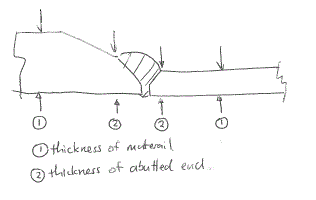mariolucas75
Civil/Environmental
Dear Forum members please help me to understand what is control thickness in PWHT.
Asme B31.3 edition 2014 says:
"The term control thickness as used in Table 331.1.1
and Table 331.1.3 is the lesser of
(1) the thickness of the weld
(2) the thickness of the materials being joined at
the weld or...."
Then it explains what is the thickness of the weld:
"Thickness of the weld, which is a factor in
determining the control thickness, is defined as follows:
(1) groove welds (girth and longitudinal) — the
thicker of the two abutting ends after weld preparation,
including I.D. machining"
So what does it mean then if i put definition of thickness of the weld into the first statement:
"The term control thickness as used in Table 331.1.1
and Table 331.1.3 is the lesser of
(1) the thicker of the two abutting ends
(2) the thickness of the materials being joined at
the weld or...."
I am confused between these two points... so the control thickness is thicker of two members being joined or thinner (lesser)... ???
Thank you very much
Asme B31.3 edition 2014 says:
"The term control thickness as used in Table 331.1.1
and Table 331.1.3 is the lesser of
(1) the thickness of the weld
(2) the thickness of the materials being joined at
the weld or...."
Then it explains what is the thickness of the weld:
"Thickness of the weld, which is a factor in
determining the control thickness, is defined as follows:
(1) groove welds (girth and longitudinal) — the
thicker of the two abutting ends after weld preparation,
including I.D. machining"
So what does it mean then if i put definition of thickness of the weld into the first statement:
"The term control thickness as used in Table 331.1.1
and Table 331.1.3 is the lesser of
(1) the thicker of the two abutting ends
(2) the thickness of the materials being joined at
the weld or...."
I am confused between these two points... so the control thickness is thicker of two members being joined or thinner (lesser)... ???
Thank you very much

